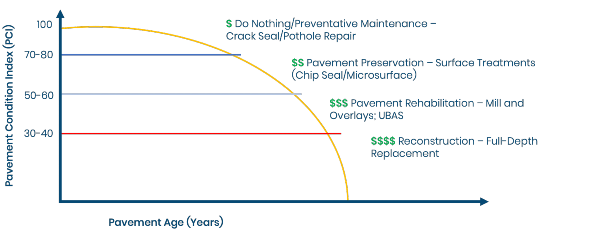Street Program
Routine street maintenance improves the quality of the roads and extends the life cycle of the street network, protecting past and future investments. Mission has developed a multi-year preservation program for the street network. The program is based on pavement conditions and available resources.
Building on the Past
Street maintenance is performed each year with available funding. Read about active infrastructure projects here.
It is important to perform periodic preventative maintenance on a street as it ages. Deciding which street treatment to use depends on how a particular street was originally constructed and where the street is in its life cycle. Many of Mission’s local/residential streets were built in the 1950s and were not constructed with sufficient asphalt thickness or subgrade that are now considered standard. This results in more rapid pavement deterioration since the thin layer of asphalt is insufficient to carry traffic volumes and continuous heavy traffic loads from buses and large trucks. Additionally, the asphalt depth is often too thin to support a mill and overlay treatment.
No matter how well a road is constructed, the asphalt will begin to deteriorate almost immediately. The life cycle curve for asphalt shows that it is more cost effective to perform routine preventative maintenance as a street ages instead of waiting until a street has failed.

Developing the Street Maintenance Program
The City has cored and surveyed all local streets to determine pavement depths and the Pavement Condition Index (PCI) for each street. The overall quality and condition of a road is measured using the Pavement Condition index (PCI). PCI is a numerical index between 0 and 100, with 100 representing the best possible condition and 0 representing the worst possible condition. Pavement features such as the existence of cracking and potholes will impact the PCI classification. PCI is not a measure of drivability. A PCI rating of 0 does not necessarily mean that a road cannot be driven, but it will give a very bumpy ride.
View the map showing PCI data for Mission streets, as collected by Stantec in 2022. This data will be reevaluated periodically as the rate of pavement degradation varies on specific streets over time.
Paving the Way: Funding the Street Program
The investment in street infrastructure is ongoing. Current efforts are focused on a 10-year street preservation program to coincide with the dedicated street sales tax. The voters approved a renewal of this tax in 2021 which will generate revenues to be combined with property tax revenues currently dedicated to street maintenance as well as with funds from the Special Highway Fund (gasoline tax) to accomplish the projects identified.
Learn more about the September 2021 mail ballot election at missionks.org/pavingtheway.
The Street Maintenance Program’s main components are:
- Routine minor maintenance by Public Works including pothole patching, asphalt base repair, minor patching/replacement of curb and gutter and sidewalk, street sweeping, cleaning stormwater inlets, etc.
- Crack Seal
- Ultrathin Bonded Asphalt Surface (UBAS)
- Mill and Overlay
- Full Depth Reconstruction
Each of the treatments the City currently uses are described below.
Crack Seal
Crack seal is usually a first defense against pavement deterioration and is typically done to newer roads with small problem areas. Crack sealant is applied to cracks to prevent water and other materials from getting into cracks. This is usually performed by Public Works crews.
Ultrathin Bonded Asphalt Surface (UBAS)
UBAS treatment is preventative maintenance tool used to help extend the life of a road by placing a thin, coarse aggregate hot mix over a special asphalt membrane. The membrane prevents water leakage and provides a superior bond to the old asphalt. The overlay can disperse water quickly off the surface which reduces roadway spray from vehicles and provides greater visibility in wet weather. UBAS can be installed quickly and lasts several years longer than a microseal treatment.
Mill and Overlay
A mill and overlay is intended to replace a failing surface. It consists of milling off the top portion of the street and replacing approximately two inches of the surface. This technique extends the life of the road in a more cost-efficient manner than a complete reconstruction.
Full Depth Replacement
Reconstruction entails removing and replacing the existing roadway and curb and gutter, adding additional asphalt, depending on existing asphalt depths, and performing any necessary subgrade modifications. Reconstruction is the most expensive of the rehabilitation methods.
Staff continues to research the most cost-effective emerging technologies to maintain and preserve streets in Mission and the types of street treatments used may change over time.
Public Works
4775 Lamar Avenue
Mission, KS 66202
Phone: 913.676.8375
Fax: 913.262.6916
Hours:
Monday – Friday
8:00 AM – 4:00 PM
Summer Hours:
Monday – Friday
6:00 AM – 2:00 PM
